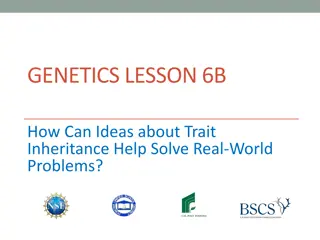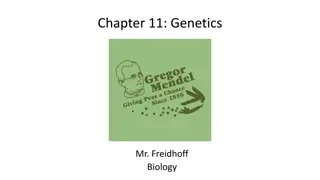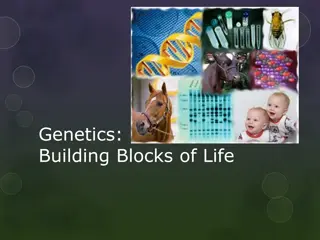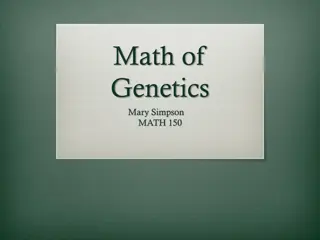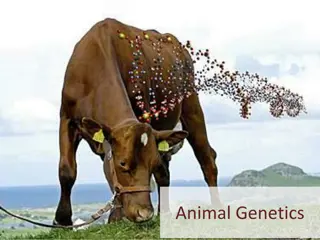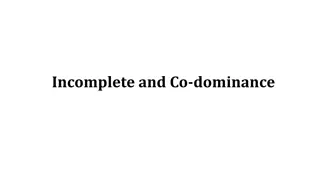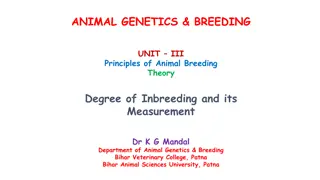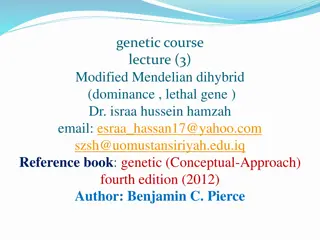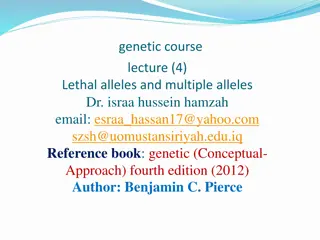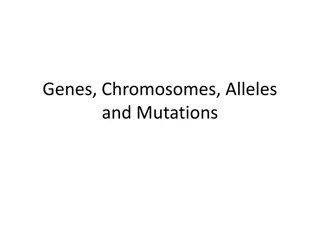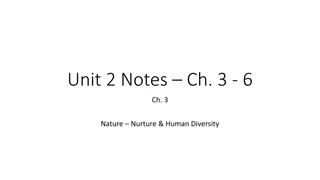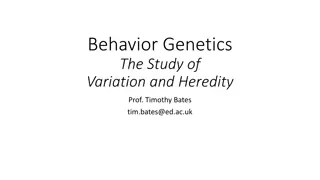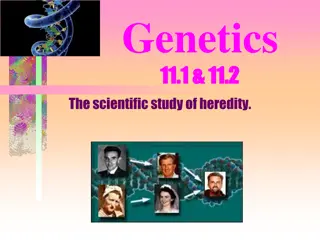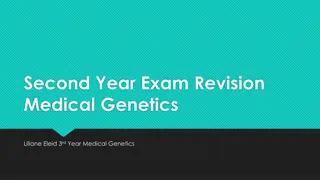Understanding Multiple Alleles in Genetics
Explore the concept of multiple alleles in genetics through examples like pea color inheritance and human blood types. Learn how multiple alleles create various phenotypes and genotypes, illustrating concepts of dominance, recessiveness, and co-dominance in genetic inheritance.
Download Presentation

Please find below an Image/Link to download the presentation.
The content on the website is provided AS IS for your information and personal use only. It may not be sold, licensed, or shared on other websites without obtaining consent from the author. Download presentation by click this link. If you encounter any issues during the download, it is possible that the publisher has removed the file from their server.
E N D
Presentation Transcript
It makes absolutely no sense whatsoever to continue if we don't know what the word "allele" means. Allele = (n) a form of a gene which codes for one possible outcome of a phenotype For example, in Mendel's pea investigations, he found that there was a gene that determined the color of the pea pod. One form of it (one allele) creates yellow pods, & the other form (allele) creates green pods.
Get it? Two possible phenotypes of one trait (pod color) are determined by two alleles (forms) of the one "color" gene. When the gene for one trait exists as only two alleles & the alleles play per Mendel's Law of Dominance, there are 3 possible genotypes (combination of alleles) & 2 possible phenotypes (the dominant one or the recessive one) If there are only two alleles involved in determining the phenotype of a certain trait, but there are three possible phenotypes, then the inheritance of the trait illustrates either incomplete dominance or co-dominance
Now, if there are 4 or more possible phenotypes for a trait, then more than 2 alleles for that trait must exist in the population. We call this "MULTIPLE ALLELES". Let me stress something. There may be multiple alleles within the population, but individuals have only two of those alleles. Why? Because individuals have only two biological parents. We inherit half of our genes (alleles) from ma, & the other half from pa, so we end up with two alleles for every trait in our phenotype.
An excellent example of multiple allele inheritance is human blood type. Blood type exists as four possible phenotypes: A, B, AB, & O. There are 3 alleles for the gene that determines blood type. (Remember: You have just 2 of the 3 in your genotype --- 1 from mom & 1 from dad). The alleles are as follows: ALLELE IA IB i CODES FOR Type "A" Type "B" Type "O"
Notice that, per the symbols used in the table above, that the allele for "O" (i) is recessive to the alleles for "A" & "B". With three alleles, we have a higher number of possible combinations in creating a genotype. GENOTYPES IAIA IAi IBIB IBi IAIB Ii RESULTING PHENOTYPES Type A Type A Type B Type B Type AB Type O
As you can count, there are 6 different genotypes & 4 different phenotypes for blood type. Note that there are two genotypes for both "A" & "B" blood --- either homozygous (IAIAor IBIB) or heterozygous with one recessive allele for "O" (IAi or IBi). Note too that the only genotype for "O" blood is homozygous recessive (ii). And lastly, what's the deal with "AB" blood? What is this an example of? The "A" trait & the "B" trait appear together in the phenotype.
The ABO Antigens The H antigen is an essential precursor to the ABO blood group antigens. The H locus is located on chromosome 19. It contains 3 exons that span more than 5 kb of genomic DNA, and it encodes a fucosyltransferase that produces the H antigen on RBCs. The H antigen is a carbohydrate sequence with carbohydrates linked mainly to protein. It consists of a chain of -D-galactose, -D-N- acetylglucosamine, -D-galactose, and 2-linked, -L-fucose, the chain being attached to the protein.
The ABO locus is located on chromosome 9. It contains 7 exons that span more than 18 kb of genomic DNA. Exon 7 is the largest and contains most of the coding sequence. The ABO locus has three main allelic forms: A, B, and O. The A allele encodes a glycosyltransferase that bonds -N-acetylgalactosamine to D- galactose end of H antigen, producing the A antigen. The B allele encodes a glycosyltransferase that joins -D-galactose bonded to D-galactose end of H antigen, creating the B antigen.
In case of O allele, the exon 6 contains a deletion that results in a loss of enzymatic activity. The O allele differs from the A allele by deletion of only one nucleotide guanine at position 261. The deletion causes a frameshift, and results in premature termination of translation, and thus, degradation of the mRNA. This results in H antigen remaining unchanged in case of O groups.
Rh Factor Another RBC antigen of major clinical concern is the Rh factor (or D antigen). This factor was first discovered in experiments exploring the genetic relationships among animals. Rabbits inoculated with the RBCs of rhesus monkeys produced an antibody that also reacted with human RBCs. Further tests showed that this monkey antigen (termed Rh for rhesus) was present in about 85% of humans and absent in the other 15%.
The details of Rh inheritance are more complicated than those of ABO, but in simplest terms, a person s Rh type results from a combination of two possible alleles a dominant one that codes for the factor and a recessive one that does not. A person inheriting at least one Rh gene will be Rh+; only those persons inheriting two recessive genes are Rh-. This factor is denoted by a symbol above the blood type, as in O-or AB+. However, unlike the ABO antigens, exposure to normal flora does not sensitize Rh persons to the Rh factor. The only ways one can develop antibodies against this factor are through placental sensitization or transfusion.
Problems A woman with Type O blood and a man who is Type AB have are expecting a child. What are the possible blood types of the kid? What are the possible blood types of a child who's parents are both heterozygous for "B" blood type? What are the chances of a woman with Type AB and a man with Type A having a child with Type O? Determine the possible genotypes & phenotypes with respect to blood type for a couple who's blood types are homozygous A & heterozygous B.
Jill is blood Type O. She has two older brothers (who tease her like crazy) with blood types A & B. What are the genotypes of her parents with respect to this trait? A test was done to determine the biological father of a child. The child's blood Type is A and the mother's is B. Dude #1 has a blood type of O, & dude #2 has blood type AB. Which dude is the biological father?


